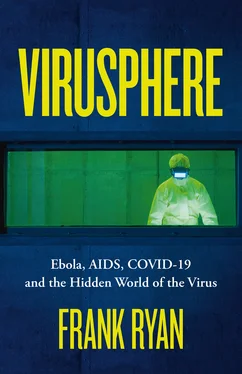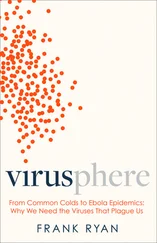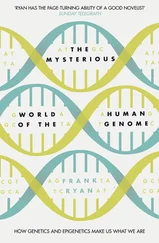When compared to the bacterial genome, the norovirus counterpart is frugal in the extreme. The viral genome comprises regulatory regions at either end of a compact linear string of RNA, which codes for a minimum of eight proteins, two of which code for the protein structures of the viral capsid, and six concerned with viral replication. A key difference between the bacterium and the virus is that the bacterium has all it needs to reproduce itself, but the virus can only replicate to produce daughter viruses by making use of the genetic and biochemical properties of its cellular host. In the case of the human strain of norovirus, these genetic and biochemical properties are those of the human target cell.
The norovirus genome codes for a singular aggressive viral protein known as the ‘protein virulence factor’, or VF1. This menacing entity localises to the human mitochondria during infection with the virus, where it antagonises the infected person’s innate immune response to the virus. While some viruses are capable of commensalism or even mutualistic interactions with their hosts, we see little evidence for this in the norovirus. Its symbiotic interaction with humans appears to be exclusively parasitic. Unlike the bacterium, it has no genes devoted to nutrition, or to internal metabolic pathways, since, unlike the bacterium, it has no internal metabolic pathways. Its genome is designed to take advantage of the physiology, metabolic pathways, genetic pathways, and even the very locomotion and life-style patterns of human behaviour in order to replicate itself and transmit its contagion as widely as possible.
So now we see that viruses are not fluids or poisons. They are organisms that follow a wide range of symbiotic interactions, each virus usually associated with a highly specific host, a tiny minority of which happen to be human. They are clearly very different in size, genomic organisation and life-cycle patterns to bacteria. The fact that most viruses do not possess their own internal metabolic processes does not imply that viruses do not utilise metabolic processes. On the contrary, viruses take advantage of their host’s metabolic pathways. This is why it is a mistake to think of viruses in isolation from their hosts. Outside their hosts viruses are biologically inactive: but this does not mean that they are inorganic chemicals.
Outside the target cells of their hosts, viruses have evolved stages that are somewhat equivalent to suspended animation. This stage is well-suited to being ejected in the aerosol created by a cough or a sneeze, or excreted in faeces, or in sexual secretions, or surviving being transferred by a secondary carrier, such as a biting insect or a rabid dog; or in the case of plant viruses, being carried to new hosts on the wind, or through water, or through a miscellany of other avenues of transmission, to find new hosts. Only when they enter into their obligate symbiotic partnership with the new host do we witness viruses behaving with the genetic and biochemical subtlety and efficiency we might expect of biological organisms.
The norovirus is no exception to such symbiotic evolutionary behaviour. So specific is the virus in its symbiotic interaction with its human host that different human-associated viral genotypes have affinities for specific ABO blood group proteins on cell membranes, these protein ‘receptors’ binding with one of the two proteins of the viral capsid as an integral step in the infectious process. On passing into the bowel, the virus has a predilection for the upper small bowel, or jejunum. How, exactly, the virus then penetrates the intestinal wall is not fully understood, but it would appear that it preferentially infects the immune lymphoid follicles in the gut wall, which are known as Peyer’s patches, while also searching out a type of intestinal cell, known as H-cells. After making its way through the gut wall, the virus is identified as alien by the innate immune defences of the gut, which might be just fine as far as the virus is concerned, since these may be its target cells. Whatever the target cells, we can anticipate that the virus will hijack their genetic and metabolic pathways in order to replicate itself, thus establishing its cycle of infection and multiplication, generation after generation.
Since we don’t yet have suitable tissue cultures or animal models to study the norovirus, we are not in a position to examine the ways in which it provokes the vomiting and diarrhoea, which play a key role in spreading the virus far and wide throughout the world. Currently there is no preventative vaccine, but trials of an oral vaccine are taking place as I write. Let us cross our fingers and hope that these trials are rewarded with an early success!
6 6. A Coincidental Paralysis 7. Deadly Viruses 8. An All-American Plague 9. Lurker Viruses 10. How Flu Viruses Reinvent Themselves 11. A Lesson from a Machiavellian Virus 12. The Mystery of Ebola 13. The Mercurial Nature of the Zika Virus 14. A Taste for the Liver 15. Warts and All 16. Lilliputian Giants 17. Are Viruses Alive? 18. Inspiring Terror – and Delight 19. The Ecology of the Oceans 20. The Virosphere 21. The Origins of the Placental Mammals 22. Viruses in the Origins of Life 23. The Fourth Domain? Bibliography and References Index About the Book About the Author Also by Frank Ryan About the Publisher
A Coincidental Paralysis Contents Cover Title Page Copyright Dedication Epigraph Introduction 1. What Are Viruses? 2. Coughs and Sneezes Spread Diseases 3. A Plague Upon a Plague 4. Every Parent’s Nightmare 5. A Bug Versus a Virus 6. A Coincidental Paralysis 7. Deadly Viruses 8. An All-American Plague 9. Lurker Viruses 10. How Flu Viruses Reinvent Themselves 11. A Lesson from a Machiavellian Virus 12. The Mystery of Ebola 13. The Mercurial Nature of the Zika Virus 14. A Taste for the Liver 15. Warts and All 16. Lilliputian Giants 17. Are Viruses Alive? 18. Inspiring Terror – and Delight 19. The Ecology of the Oceans 20. The Virosphere 21. The Origins of the Placental Mammals 22. Viruses in the Origins of Life 23. The Fourth Domain? Bibliography and References Index About the Book About the Author Also by Frank Ryan About the Publisher
In the summer of 1921 the 39-year-old Franklin D. Roosevelt fell overboard from his yacht on the Bay of Fundy, a beautiful if freezing inlet between the eastern Canadian provinces of New Brunswick and Nova Scotia. The following day he was tormented by pain in his lower back and then, as the day progressed, he felt his legs grow increasingly weak until they could no longer sustain his body weight. This was the onset of Roosevelt’s poliomyelitis, at this time known as ‘infantile paralysis’. Poliomyelitis is caused by a virus that goes by the same name. In 1921 doctors were limited in their knowledge of the poliovirus, or indeed viruses as such. They might, however, have known that the virus did not infect Roosevelt while he was struggling in the cold water – the only infectious source of poliomyelitis virus is another person who has already contracted it. Once again, we are looking at an exclusively human reservoir. Moreover, the paralytic disease has an ancient pedigree.
Infantile paralysis was familiar to physicians in the time of the pharaohs of Egypt, since the effects of the disease were painted, with stunning accuracy, on the walls of their tombs. In 1921, as indeed today, there was no cure for the paralytic effects of the virus once it had afflicted a victim. Fortunately, Roosevelt was gifted with an extraordinary vitality and courage, enabling him to overcome the lifetime of paralysis that would result from his illness. It is to his credit that despite this handicap he became the 32nd President of the United States and he continued to serve the American people for an unprecedented four terms in office.
Читать дальше












